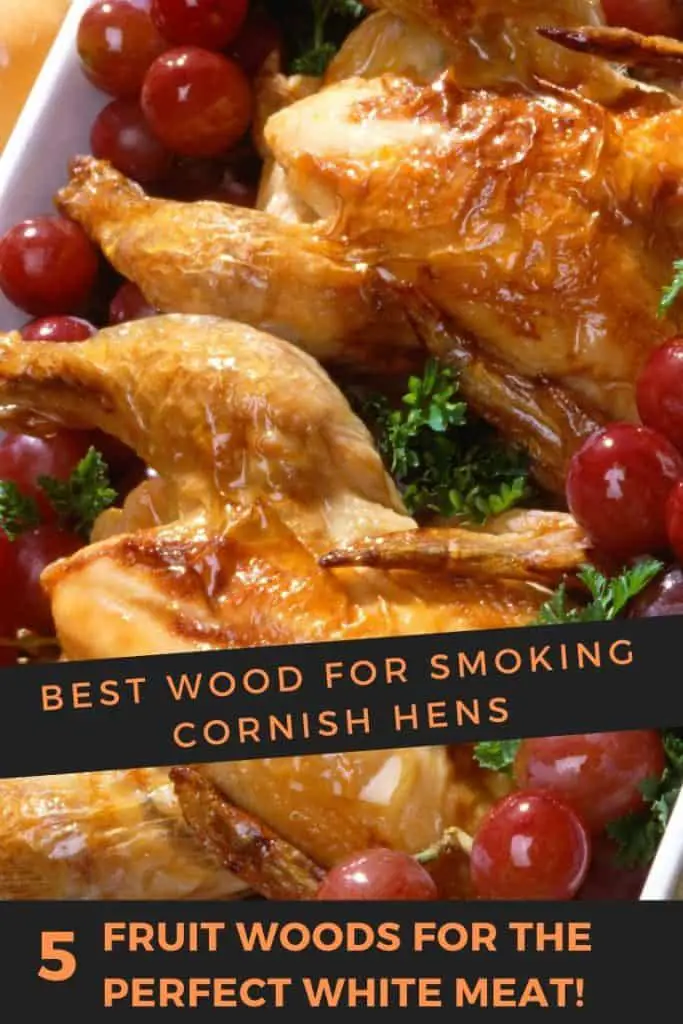Thinking of smoking up a delicious Cornish hen dinner?
Cornish hens are a great alternative to chicken because they are small and cook quickly. Each hen is an individual portion ready to serve.
But, to get the best flavor from them, you need to choose the right wood. Wood smoke is an excellent option because it cooks meat slowly and indirectly at low temperatures.
Select the right smoke wood, and you’ll get the most flavor from your poultry! In this post, I’ll help you choose the right wood for the job.

The best wood you can choose when smoking these hens are fruit woods, let me explain below.
In this post we'll cover:
Choosing the right wood for smoking cornish hens
To get a great tasting Cornish hen, you need to start off right, by selecting the best wood to accompany their taste.
Think of smoking wood as a type of seasoning – different woods give different distinct flavors to the meat.
Most smoking and grilling experts agree that fruit woods are the best choice for smoking Cornish hens. However, other wood options deliver great taste as well, so really, it’s about personal preference.
Keep in mind that certain woods work well when cooking poultry, whereas other types are better for pork, beef, seafood, and other meats. Think of smoking as an extra ingredient that may either complement the dish or not, so choose wisely!
Before buying the wood, look for quality wood. Fresh wood is heavy, unlike old dry wood, which only smokes in excess. Make sure you decide if you are going to use chips or wood chunks because chips will burn faster and affect the cooking time.
Fruit woods
The best woods for smoking Cornish hens are fruit woods.
Here are the most popular options:
- Pecan: It is considered a smoking wood of superior quality. This wood is perfect for poultry since it has a mild flavor; it is rich and has a nutty, sweet taste.
- Maple: The flavor is slightly sweet and mellow, but Maple gives that smoky aroma and is considered a subtle smoking wood.
- Apple: This wood is excellent for poultry because it has a subtle and mild flavor and fruity taste that’s not too sweet. Applewood enhances the warm flavors of white meat. It also gives the hens that dark brown crispy skin.
- Cherry: True smoke fans know that cherry wood is one of the best choices for Cornish hens because it’s the perfect combination of fruitiness and mild flavor.
- Peach/Apricot/Plum/Nectarine: Known as sweet fruit woods, these woods will give the meat a much sweeter taste.
These are my favorite woods for smoking cornish hens:

Pecan wood chips:
Western Premium
Maple wood chips:
Western PremiumCheck out the BBQ smoker products I use in all of my cooking here in my recommended products list.
I’ve found that pecan wood is also perfect for smoking almonds when writing my article on that here. Not as good as some of the fruitwoods though, but you can read about that in that article.
Hardwood
- Hickory: This is a hardwood with a strong taste that is slightly sweet. It burns slowly at a very hot temperature. Fans of hickory appreciate its bacon-like flavor. Hickory is popular for smoking ribs, but it also adds intense flavor to poultry.
- Alder: Gives poultry a soft taste with just a hint of sweetness, and it’s a good option for those looking for only a slight smoke flavor.
- Mesquite: This wood is used for all types of meat and has a rich and intense flavor that is well known to BBQ lovers. Mesquite is the hottest burning wood, so be careful you don’t overcook the hens.
Which woods to avoid when smoking cornish hens
As a general rule, you should avoid all softwoods. Stay away from conifers such as pine, redwood, cedar, cypress, fir, and spruce.
Softwood trees contain a high level of sap and terpenes, which can make some people feel sick and give your meat an odd, unpleasant taste.
Avoid any wood that contains fungus on it because it will give your meat an awful taste. Make sure you choose wood that is not moldy or rotten anywhere because it can include some toxins which are dangerous for human health.
Oak: This wood is popular for smoking, but it’s not recommended for Cornish hens because it’s too strong and more suitable for red meats like beef and lamb.
Ideal smoking and cooking conditions
Cornish hens are small; thus, they cook fast and don’t need more than 1.5 hours to smoke.
The hens can be cooked at 325 degrees Fahrenheit, but experts suggest smoking the Cornish hens slowly on low heat between 225 – 230 degrees. When the hens are almost cooked, turn up the heat for extra crispy skin.
Most grillers will agree that you must smoke meat for at least 20 to 30 minutes to achieve a distinct flavor, but wood smoke is best used for cooking slowly at a lower temperature, so give yourself a good 2 hours for the whole process.
The hens should have an internal temperature of 165 degrees to be fully cooked.
For an extra hint of flavor, add herbs such as rosemary and a few sprigs of thyme to the grill when smoking. Cornish hens should be marinated for about 2 hours in the fridge with an excellent dry rub prior to smoking.
For the best results, try soaking the wood chips or chunks in water a couple of hours prior to smoking and remember that the more wood you use, the more intense the flavor will be!
Also a great way to smoke is with this wood type for the best tasting chili you’ve ever had!

